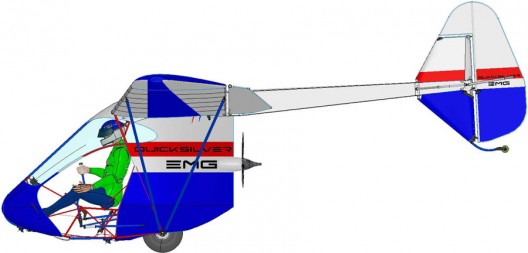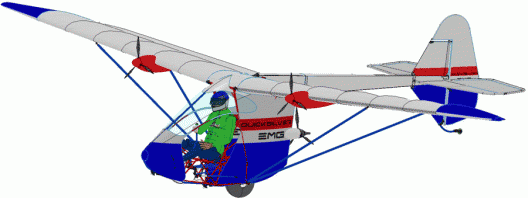Brian Carpenter of Adventure Aircraft Inc. (part of his Rainbow Aviation Company) must trust his engineering, since he acted as his own test pilot for the first flights of his EMG-6 ultralight glider, a craft with options of mounting one, two, three (or even four, as Brian suggests) electric motors. As an ultralight motor glider it can carry a pilot, ballistic parachute, and a small powerpack with one motor, controller and batteries. Depending on the pilot’s weight, the airplane might be able to self launch and reach soaring altitude, or for heavier payloads, use the motor as a sustainer unit after a ground or aircraft tow to seek out distant thermals.
While waiting for this next development, look at the number three test flight, towed from the runway by a “quad” all-terrain vehicle (ATV) and on landing demonstrating a remarkably short landing roll into only a 9-mph wind.
Currently favored, the Plettenberg Predator motor and a Schulze 400-Amp motor controller are lightweight and capable of producing 15 kilowatts (20 horsepower) and 99 pounds of thrust with a RASA folding propeller. This combination weighs a mere 5.36 pounds according to Brian’s shop scales – on which every component has been weighed while he calculates how to remove important ounces from each.
Brian is designing a controllable-pitch propeller to improve climb and cruise performance, a rarity so far on electric aircraft. A series of different powerplant configurations would add power and might act as range extenders. Offsetting the aerodynamic drag of the semi-open cockpit, the rear fairing directs airflow from around the pilot to cool the batteries, motor and controller.
Detachable pods on the wings would enable use of self-contained electric or two-stroke model airplane systems, complete with fuel or batteries. A full complement could triple power and allow the airplane to fly with an instructor or passenger.
Brian is also looking at more substantial (and costly) Plettenberg motors. The Nova 15 weighs only 2.5 kilograms (5.5 pounds) and puts out 15 kW and 30 Newton meters (22.1 foot-pounds) of torque at 4,900 rpm. The Nova 30 produces 30 kW at a lower 3,300 rpm while developing 105 Nm (77.4 ft-lbs) of torque. This five kilogram (11 pound) motor could swing a large propeller and provide a huge boost in climb performance.
We look forward to more test flights and performance testing with a variety of thrust-producing systems in 2014.



Comments 1
you are on the right track and battery development is going to be advancing to provide lighter and better range. anxious to see you advance the development of electric ultralight motor glider aircraft.
bob speakman